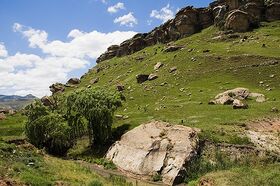Battle of Kushineda's Hill: Difference between revisions
No edit summary |
No edit summary |
||
| Line 5: | Line 5: | ||
| image = [[File:KushinedasHill.jpg|280px]] | | image = [[File:KushinedasHill.jpg|280px]] | ||
| caption = Kushineda's Hill (formerly, Surrender Hill) in 2022 | | caption = Kushineda's Hill (formerly, Surrender Hill) in 2022 | ||
| date = 2 December 2036 - 5 | | date = 2 December 2036 - 5 March 2037 | ||
| place = [[Kushineda's Hill]], [[Rhodeia]] | | place = [[Kushineda's Hill]], [[Rhodeia]] | ||
| result = Heimdallr Victory<br/> | | result = Heimdallr Victory<br/> | ||
Revision as of 16:14, 27 October 2022
This article is incomplete because it is pending further input from participants, or it is a work-in-progress by one author. Please comment on this article's talk page to share your input, comments and questions. Note: To contribute to this article, you may need to seek help from the author(s) of this page. |
The Battle of Kushineda's Hill (2 December 2036 - 5 March 2037) lasted for 83 days in 2036 to the spring of 2037, after the Neocon forces under the command of General Grant Vaughan attempted to regain the initiative in Rhodeia by attempting to seize control of the town of Mutoko in order to create a point from which he can take control of the seemingly vital Magnolia-Vandemeersburg Road. Vaughan eyed the capture of the Rhodeian Port of Vandemeersburg, which was the largest port in Africanna, and the largest city in Rhodeia. Vaughan hoped to control the port city in order to open shipping to Neocon supplies coming from Quenmin and Indiae. These supplies would also prove to be of use for his planned invasion of Basel-Ebel, eyeing to reach the Cape of Blessed Hope by mid-2037, expelling the Heimdallr forces and governments, and installing Neocon governments in Basel-Ebel, Rhodeia, and Arithea by the end of the year.
During Operation Claim, the Neocons launched a savage offensive hoping to push the Heimdallr Forces further south from the Arithean border, preventing the link-up of Archadian forces and the rest of the SADC. A garrison based just near Rusape, consisting mostly of the famed Long Range Reconnaissance Group under Colonel Yukio Kushineda V remained behind from the retreating SADC and organised a stand at Surrender Hill to deny the vital highway from the Neocons, preventing them from advancing and reaching Vandemeersburg, while the SADC reorganised and prepared for a counteroffensive.
Historically, Surrender Hill had been the site where the last Domonokian forces surrendered during the Lucio-Domonokian Wars. General Vaughan had hoped to force Kushineda and the LRRG to surrender at where they stood, owing to the name of the hill. The Neocons threw a massive attack on 2 December and it continued for the next 2 months. On Christmas Day and New Year's Eve, the Neocons threw massive attacks on the defenders of the hill but the defenders on the hill still remained unscathed. The occupation of the hill deprived the Neocons of the vital highway that ensured them a dagger-thrust to Vandemeersburg. RRAF and RBEAF fighters provided air support for the defenders while cargo planes dropped supplies and food.
The siege on the hill had ruined Vaughan's timetable for capturing Vandemeersburg. He immediately diverted reinforcements but the garrison still repulsed several Neocon attacks. The outpost was frequently bombarded and armoured reinforcements were frequently sent to the hill as RRAF and RBEAF flew defensive sorties just near at Magnolia. Later on, Vaughan sent Task Force Nicator in an attempt to raid the outpost. In spite of sending special forces units and heavy arsenals, Kushineda still held control of the hill. In 27 February, the SADC had reorganised and launched a counteroffensive against several Neocon positions near the hill. In 5 March, elements of the 4th Basel-Ebelian Armoured Division relieved the defenders on the hill.
The Neocon defeat at Surrender Hill is labelled as the Neocons most humiliating defeat of the war, where General Vaughan's overconfidence over the smaller force became his own undoing. Despite the LRRG's meagre numbers, the small elite patrol force, along with elements of small native groups had successfully held off a large Neocon formation for 3 months, which denied the vital port to the Neocons and also sealed the fate of further Neocon advances to Rhodeia. Following the battle, the LRRG's members were awarded with many decorations. Kushienda was promoted to Brigadier, and the hill was renamed to its present name of Kushineda's Hill after the latter in honour of his extraordinary stand.
